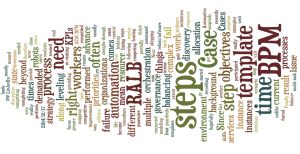I recently participated in a ABPMP LinkedIn group discussion “What do you think are the most demanded BPM services (for 2015 and beyond)?”
We started off listing the “services” as “discovery, mapping, modeling, analysis, improvement, automation, discovery”.
From my experience, most BPM initiatives that fail, fail in “automation”, therefore this is the service area that should be in demand.
By “automation” I don’t mean having all process steps performed by robots/software. Automation here refers to “orchestration” (guidance) and “governance” (guardrails).
When you have complex processes comprising steps connected often in complex ways, where different skills are needed to perform different steps, it’s unreasonable for any BPM initiative to quit with “publication of a paper process map”.
The real life scenario is you will have multiple process templates, with multiple instances of each at each Case, with deviations at certain steps along instances (skipping over a step, re-visiting already committed steps, inserting steps not in the template, recording data and partially completing steps that are not yet current along an instance).
The other reality is there usually are scarce resources and competing priorities with the result that the time to run through an instance is greater than the sum of step durations.
The fact that users often are forced to multi-task results in extra time above and beyond wait times between steps. Each time a worker suspends work at a step, there is an exit time and then a re-entry time when he/she comes back to the step.
So, it follows that organizations need automated resource allocation, leveling and balancing (R.A.L.B.).
We can look to background BPM and R.A.L.B.to provide resource allocation providing there is an environment to host R.A.L.B..
Since workers are not robots and do not like to be treated as robots, organizations need to empower workers to micro-schedule their task loads (leveling).
Since priorities can change, supervisors need to be able to balance workload across workers (balancing).
But, we are not done – we need “governance” in addition to “orchestration” and this, hopefully, comes from the Case environment that is hosting R.A.L.B.and background BPM.
Next, there is the issue of managing Cases – you can very easily be doing things the right way but not doing the right things.
Following a template can guarantee that you get the right result but it does not mean that use of the template will advance the state of the Case.
In ACM/BPM, unlike straight-through mostly linear processes, there are no convenient objectives at the end of a template.
What counts is progress toward Case-level objectives. Any work that does not directly or indirectly advance the state of a Case should not be performed.
Finally, we have the issue when defining Cases that Case objectives should at all times be supportive of strategy and conceptually, at least, contribute to “competitive advantage”.
A worthwhile focus for any management consultant for 2015 is to help corporations become more aware of the extent to which their KPIs are relevant in the context of where they want to be 1-2-3 years from now.
Too often, I find they are looking at the wrong KPIs because of failure to keep strategies current and failure to close the gap between operations and strategy.


Re-blogged to BPMLeader
http://www.bpmleader.com/2015/02/09/where-do-we-go-from-here-with-bpm/
LikeLike
Thank you very much, your blog commenting lists are great help to me in building inbound links to my blog
LikeLike